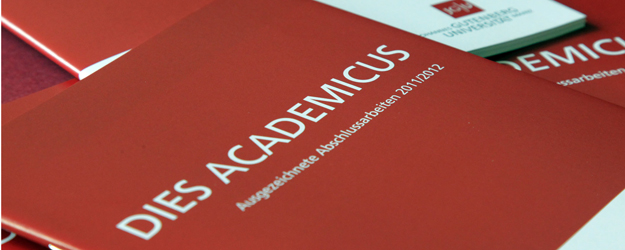3 July 2012
On its Dies academicus, Johannes Gutenberg University Mainz (JGU) celebrates its young researchers. 14 outstanding dissertations were honored this year. In his ceremonial address, Dr. Andreas Brandtner, Director of the University Library, dealt with a topic that has come back into style after being long ignored: university collections.
There are huge challenges when it comes to data protection. The individual's right to informational self-determination is under threat. Increasingly sophisticated technologies are making it possible to collect ever more data and, with the terrorist attacks of 9/11 more than just a memory, many governments have good reasons to examine these data more closely. There is no doubt in the mind of Dr. Eva Aernecke – it has become necessary to put in place a new basic right that will afford effective protection of the citizen. She has formulated a corresponding proposal in her dissertation "The protection of electronic data under constitutional law – the threat represented by new identification methods."
"It is my honor to welcome you to this, our foremost academic celebration," said Professor Dr. Ulrich Förstermann, Vice President for Research at Johannes Gutenberg University Mainz (JGU), in his opening address for the Dies academicus. The Alte Mensa is the venue in which this annual celebration of outstanding doctoral dissertations takes place and it is on this day that JGU's leading young researchers come into their own. This year, foundations and private organizations, such as the Friends of Mainz University and the Rheinland-Pfalz Bank, donated awards worth a total of EUR 33,000.
EUR 33,000 for dissertations
Dr. Aernecke, a legal scholar, received an award from the Dr. Feldbausch Foundation for her work on data privacy. Dr. Daniel Stephan Jussen, a doctor of human medicine, was honored by the Boehringer Ingelheim Foundation. He has been working on an improved method of eliminating hematomas in severe intracranial injury.
Statistics show that thirty percent of patients with traumatic brain injuries die as a result of hemorrhaging. "An essential element of treatment in addition to dealing with the primary injury is to limit secondary injury to the brain," Jussen explained. He uses a method derived from shock therapy which involves the intravenous administration of hypertonic-hyperoncotic solutions to significantly reduce cerebral injury. This has already worked in rats and could improve the chances of recovery for many patients in the future.
14 awards for young researchers
The Dies academicus is an occasion for celebration. And it was apparent that the chic dresses and stylish suits worn by some of the fourteen award winners were not part of their everyday wardrobe. A choice musical program and a ceremonial address are, of course, required features on a day like this.
Dr. Andreas Brandtner, the Director of the University Library since 2011, chose a subject that was once at the focus of attention, only to be later largely neglected but that has now, once again, become a hot topic. The title of the lecture by Brandtner, who was born in Austria, was "The logic of university collections. Perspectives in research, teaching, academic communication, and museum conservation".
Of old treasures in the basement
In 1779, Georg Christoph Lichtenberg praised the Academic Museum in Göttingen. It was the first of its kind to be established at a university and its collection represented a marked breach with the old concepts of the cabinet of wonder and curiosities. In the true spirit of the Enlightenment, it was not intended to merely evoke marvel or be a vehicle for ostentatious display. The museum was designed to be used for teaching purposes. And it set a precedent. Even Wilhelm von Humboldt considered such a collection to be indispensable when he founded the University of Berlin.
Brandtner then jumped a good 200 years from the time of Lichtenberg and Humboldt to the present. Today, many universities seem to be embarrassed by their collections – "so much so that they have to hide them in their basements." Neglected, threatened with destruction, they eke out a marginal existence. "There are about 1,000 collections at 86 German universities." In Mainz alone, there are 21, including the Ethnographic Collection, the Mineralogical Collection, and a collection of ancient Grecian vases owned by the Department of Classical Archaeology. A few dedicated colleagues are already involved in ensuring that these remain part of everyday life of the university.
Collections are important resources
But apart from this, there are currently nationwide initiatives to reactivate the collections, as well as catalog and preserve them. This is something that Brandtner also advocates: "If we are again made aware of their qualities, we will understand them as resources." They could play a role at the intersection between research and teaching. But they could also interest a wider public if put on display.
Brandtner hopes that his library will be able to function as a coordination center for the various collections and their curators. On a day on which young researchers were being honored in the presence of many dignitaries, Brandtner took the opportunity to dust off these old treasures and ended with a caveat: "There is one thing we need to bear in mind: If they are to be worthwhile, we will need to spend money on them."



